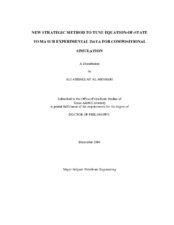| dc.description.abstract | Since the plus fraction of reservoir fluids has some uncertainty in its molecular weight and critical properties, equation-of-state, EOS, are generally not predictive without tuning its parameters to match experimental data. Tuning of the EOS is found to be the best method for improving the predictions of compositional reservoir simulators.
The proposed strategy for tuning EOS consists of seven steps: (1) split the laboratory plus fraction to single carbon number groups, SCN, usually up to SCN 44; the last component will be C45+, (2) use set of correlations to calculate the critical properties and acentric factor for each SCN group, (3) match the saturation pressure at reservoir temperature by altering the measured value of the molecular weight of the plus fraction using the extended composition, (4) group SCN groups to multiple carbon number groups, MCN, (5) assign critical properties and acentric factor for each MCN group, (6) rematch the saturation pressure at reservoir temperature using the grouped composition, and (7) match the volumetric data by regressing on volume shift parameters of all components in grouped composition.
This research shows an accurate method to split the plus fraction to SCN groups. The most accurate set of correlations to calculate the critical properties and acentric factor for each SCN group that will result in a small adjustment for the molecular weight of the plus fraction when saturation pressure is matched using the extended composition. The proposed strategy groups the extended composition to eight pseudocomponents. The binary interaction coefficients between hydrocarbons and between hydrocarbons and non-hydrocarbons are set to zero which dramatically reduces the simulation time.
The strategy proposed in this research for tuning EOS to match experimental data has been tested for a wide range of C7+ mole% (4 – 25) which covers gas condensate and volatile oil samples. Also, using this strategy to tune EOS at reservoir temperature will accurately predict the fluid properties at separator conditions and saturation pressures at different temperatures.
The scope of this research is to come up with an accurate and systematic technique for tuning an EOS for use in compositional simulation. | en |


